Best Time to Visit Tokyo: A Season by Season Guide
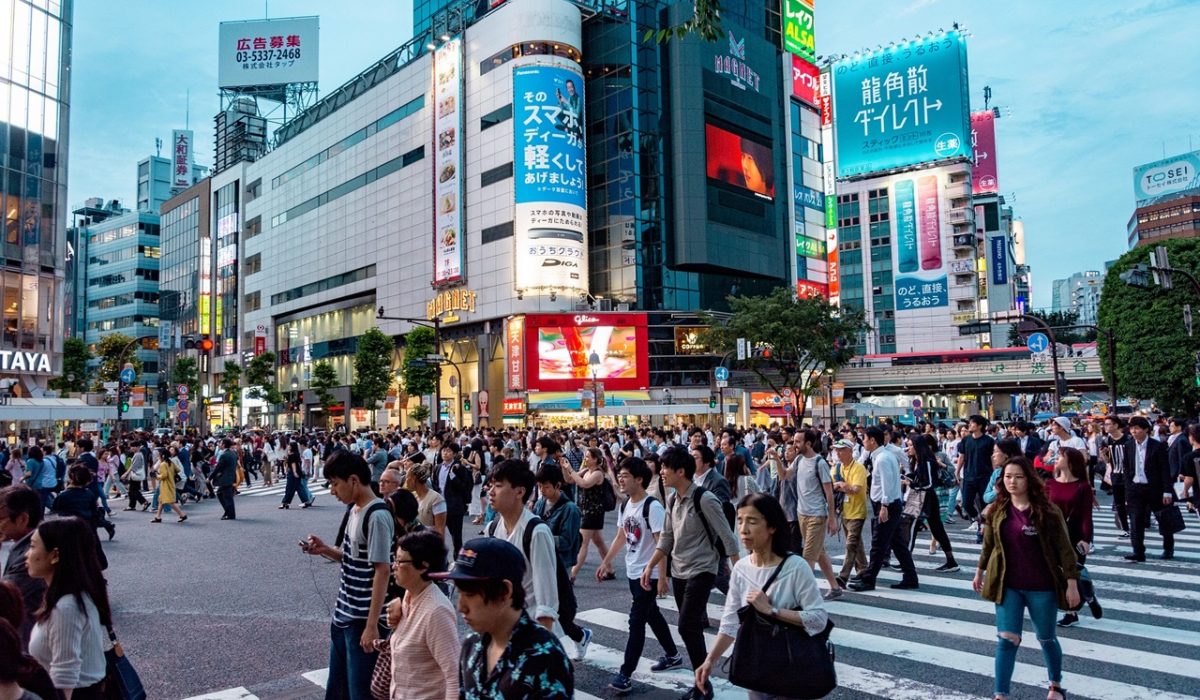
For every traveler, Tokyo is a must-visit city on their bucket list. Whether it be shopping in Harajuku, heading to the top of the Tokyo Skytree, witnessing the cherry blossom trees in hanami, or visiting the Tsukiji fish market, the Japanese capital has been a well-loved destination for so many years. After all, it is the country’s cultural, political, and economic center. But before booking your plane ticket and checking out the best Japanese onsen, it’s important to know the best time to visit Tokyo.
Knowing when is the best time of the year to visit Tokyo is also important as it can make or break your whole trip. The last thing you want on your trip is to miss the cherry blossom viewing season when that was the whole point of your trip or not being able to enjoy most of the attractions at Disney Resort because there are twice as many people.
So if you’re planning to spend a week or two in Tokyo, here’s everything you need to know about the weather in Tokyo, its high and low tourist seasons, and the best time to visit the city depending on your purpose of travel.
Best Time to Visit Tokyo
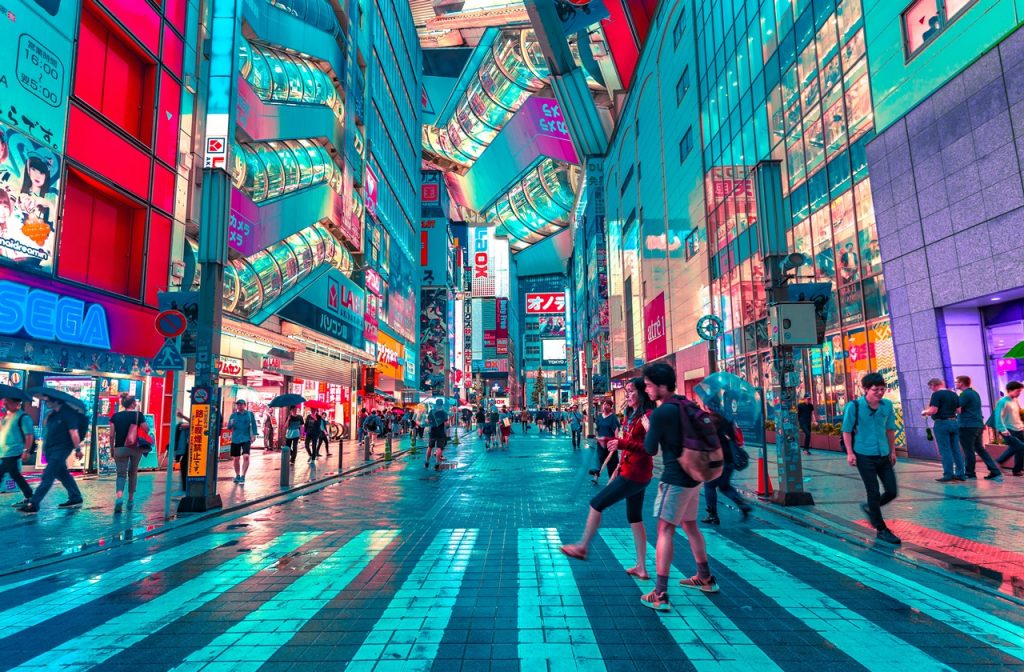
Photo by Jezael Melgoza on Unsplash
In short, the best time to visit Tokyo depends on your purpose of travel. If you want to see the cherry blossoms in Ueno and other city parks, plan your visit in late March or early April. On the other hand, fall foliage is best seen from late October to November. For shopping aficionados, grab the best deals at clearance sales in December and July. If you want to avoid the crowds, plan your visit during the low season in winter. Additionally, any of the shoulder seasons between spring, summer, and autumn is also a good season.
For Shopping
Shopping is easily one of the best things to do in Tokyo. From the high-fashion shops of Harajuku to the endless boutiques at Shinjuku, Tokyo has pretty much anything and everything for you. Although it can be intimidating to find out which district in Tokyo to visit depending on what you want to buy, shopping in Tokyo is an exciting experience. Most stores in Tokyo also offer tax-free shopping, so all you need is your passport and you’ll be able to find great deals.
That being said, the best time to shop in Tokyo is during its clearance sales by the end of July and during the year-end holiday season. You can find irresistible deals at both department stores and smaller boutiques along the street. Do note that these sales attract plenty of crowds, almost like a festival, so expect a huge number of shoppers. Most shops are closed on Mondays while some close on Wednesdays. Sunday is usually the busiest day where families tend to go out together. If you plan on shopping in Tokyo, make sure to arrive before the shops open and go on a weekday.
For Sightseeing
Sightseeing is without a doubt the most popular activity in Tokyo, with hanami being the most-awaited sightseeing event. Although hanami varies every year, these trees normally bloom from late March to mid-April. During the cherry blossom viewing season, find city parks, gardens, and castles surrounded by breathtaking sakura trees. Under the trees, people sit on picnic mats having a drink or two while admiring the beauty of the trees. Since this also occurs in the high tourist season, expect plenty of crowds. Even the Imperial Palace, one of the best places to view the cherry blossoms, is flocked by tourists and locals. On the other hand, if you go in early March or late February, you’ll be able to see the plum blossoms which are equally as charming.
October to November is another best time to visit Tokyo for sightseeing as the weather is chilly and mild. There’s little rainfall and the temperature is perfect for heading to the temples and taking photos of the autumn foliage. If your main purpose in going to Japan is to see its popular landmarks like the Tokyo Skytree, Tokyo Disneyland, and more, avoid July and August. As these are the peak months, the weather is hot and humid, and you’ll encounter a lot of other tourists.
For Fewer Crowds
If you want to avoid the huge crowds, it’s best to visit Tokyo during the low season in winter, from December to February. While most tourists escape to places with warmer climates, winter in Tokyo is a wonderful experience. You can witness the winter illuminations, see the light show at Tokyo Tower, and shop at the Christmas markets. Aside from exploring Tokyo itself, winter is also a great time to explore other cities. You may find and take advantage of the hot spring resorts and traditional inns. One advantage of traveling during the low season is the cheaper rates for plane tickets, hotels, and activities.
February is also a quiet month in Tokyo, perfect for tourists who prefer crowd-less sightseeing trips. There are few festivals in February and the cherry blossom trees are not yet in bloom. However, this month is when plum trees shine. The Yushima Tenjin Shrine in particular celebrates its Ume (plum blossom) Festival sometime from February to March. Since February is also one of the coldest months of the year, this is a great time to visit an onsen or take a trip to the mountains for skiing and other winter sports.
Seasons in Tokyo
Understanding the weather is one important step in knowing when is the best time of the year to visit Tokyo. If you’re planning on viewing the gorgeous fall foliage from the temples or enjoying the crisp summer weather, it’s best to get a better understanding of the weather in Tokyo.
Spring in Tokyo
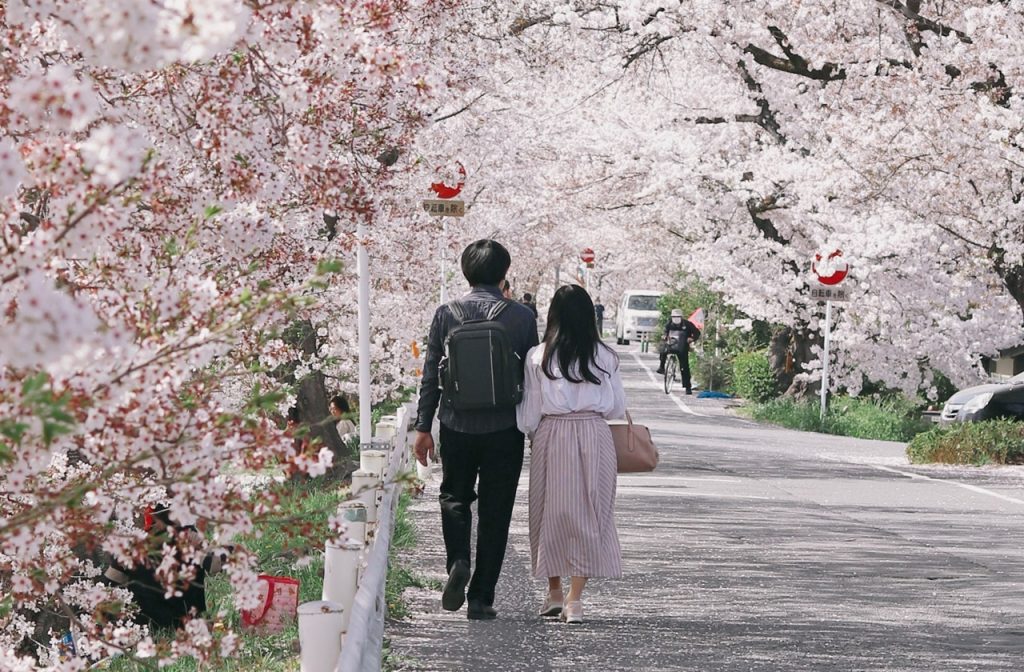
Photo by Amy Tran on Unsplash
Spring in Japan is from March to May, marked by the much anticipated cherry blossom viewing season. The weather is generally cool and sunny, although rainfall is still common at night, so it’s best to pack an umbrella and light jackets for the weather. In April, the weather then turns pleasantly warm, with the weather at night perfect for evening hanami parties. Towards the start of May as the temperature rises, expect rainy days and higher humidity levels, so you can switch your thick jackets and coats for long-sleeved tops and cardigans.
Generally speaking, spring is the best time to visit Tokyo although it is also the busiest. The months of spring are also famous for the iconic hanami season and other festivals in Japan like the Doll Festival and the Three Shrine Festival. If you plan on visiting the city, make sure to secure your tickets and accommodation in advance.
Festivals and Events in Spring
Aside from hanami, Tokyo celebrates different festivals and events that center around spring. Given the beauty of the surroundings brought by the cherry blossom trees, adding in the lively festival happenings gives it an unforgettable touch.
Sanja Matsuri (Third Sunday of May) – One of the biggest and wildest festivals in Tokyo. Held at Asakusa Shrine in honor of the three men who founded the Sensō-ji Temple.
Tokyo International Anime Fair (Late March) – The largest anime trade fair in the world and one of the more modern events held in spring. It covers anime and manga-related conferences, interviews, and performances.
Ueno Sakura Festival (Dates subject to change every year) – In spring, Ueno Park turns into an ethereal venue to watch the cherry blossoms. At nighttime, there are plenty of lanterns on display, making it a must-see hanami spot.
Weather in Spring
| Month | March | April | May |
|---|---|---|---|
| Average Temperature | 5 to 13°C (41 to 55.4°F) | 10 to 19°C (50 to 66.2°F) | 15 to 23°C (59 to 73.4°F) |
| Average Precipitation | 120mm (4.7in) | 125mm (4.9in) | 140mm (5.5in) |
Summer in Tokyo
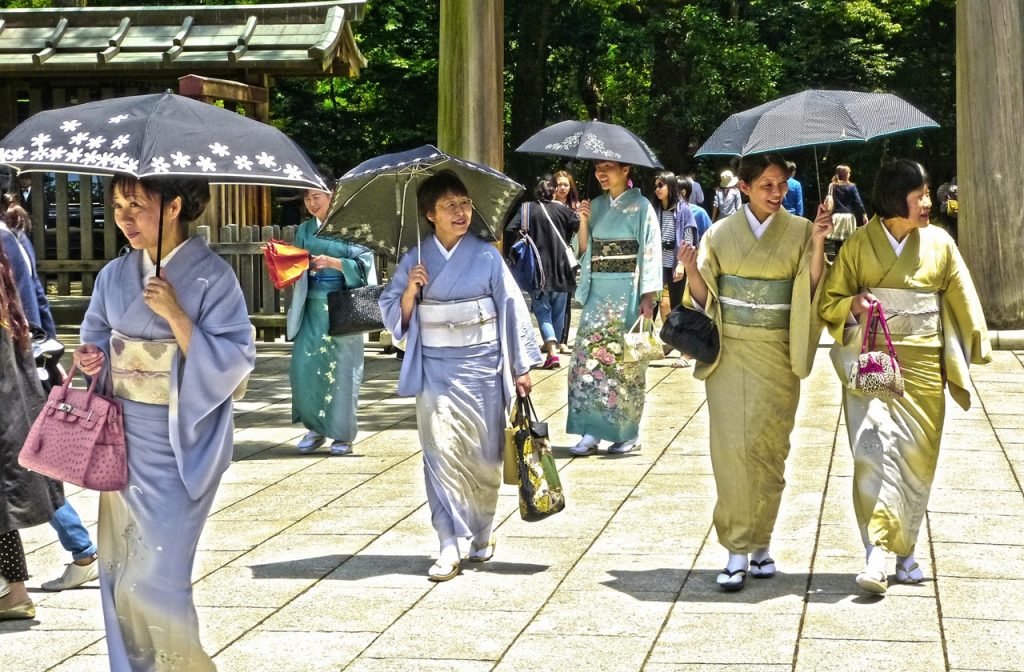
Photo by cegoh on Pixabay
The months of June, July, and August are Tokyo’s summer months and thus, the hottest and busiest months. June starts the so-called 6-week rainy season, so have your light jackets and umbrellas prepared. Given the rainy weather, the hydrangeas are in bloom and are a sight to behold and you can visit Sumida Park or Tokyo Summerland to see these. July sees a transition from rainy weather to hot. By August, you can start wearing short-sleeved shirts and sundresses with breathable fabric, as it is the hottest month.
Despite the humid and rainy weather, summer is the best time to visit Tokyo for festival enthusiasts. The Sannō Festival and Obon Festival are two popular festivals in the city and are the perfect opportunities to learn more about the culture. Fireworks festivals, firefly-viewing festivals, and other summer events attract plenty of tourists as well. Beaches, amusement parks like Disney Resort, and other attractions are packed with families and locals enjoying the beautiful weather.
Festivals and Events in Summer
Summer is definitely the best time to visit Tokyo if you want to witness gorgeous fireworks festivals. Because of the beautiful weather, you can also witness street dance parades and other jovial events in the city.
Sumidagawa Fireworks Festival (Last Saturday of July) – Attracting over a million spectators, this is one of the biggest summer festivals in the country. The riverbank of the Sumida River provides an excellent view of the breathtaking fireworks.
Fukagawa Matsuri (Between June and August) – One of the three great Shinto festivals along with Kanda Matsuri and Sannō Matsuri. More than 50 mikoshi (portable shrines) are paraded along the neighborhood accompanied by a thrilling water-splashing event.
Harajuku Omotesando Genki Matsuri (Last weekend of August) – A multi-day street dance festival featuring the Yosakoi dance, a traditional dance that originated from Kochi Prefecture.
Weather in Summer
| Month | June | July | August |
|---|---|---|---|
| Average Temperature | 19 to 26°C (66.2 to 78.8°F) | 23 to 30°C (73.4 to 86°F) | 24 to 31°C (75.2 to 87.8°F) |
| Average Precipitation | 170mm (6.7in) | 155mm (6.1in) | 170mm (6.7in) |
Autumn in Tokyo
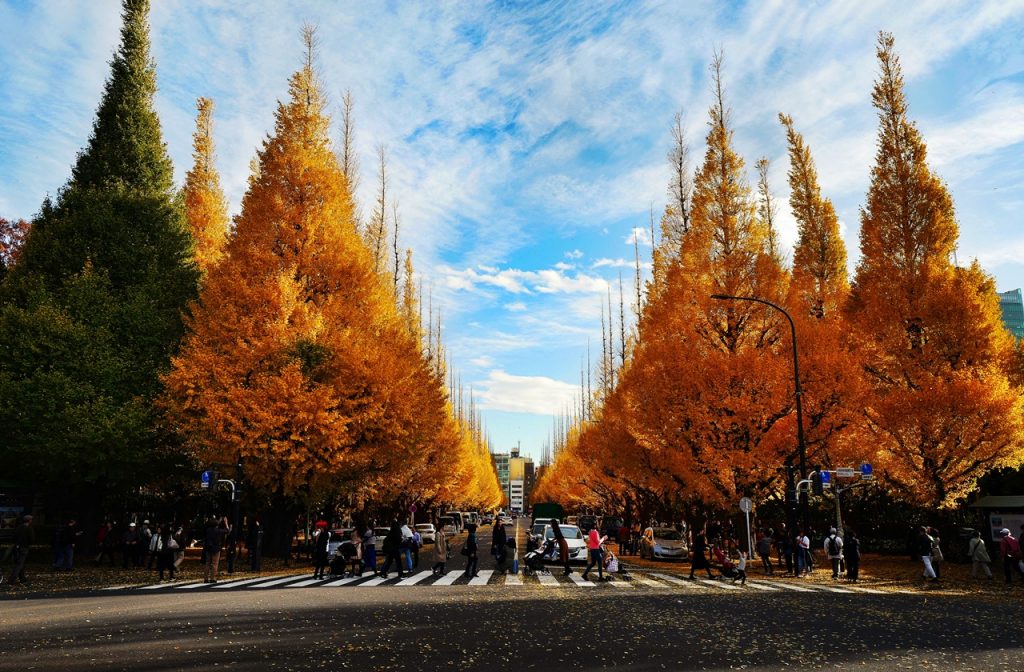
Photo by Tom Tor on Unsplash
Autumn in Tokyo runs from September to November and transitions from rainy to picture-perfect thanks to its fall foliage. September is the city’s wettest month and not exactly the best time to visit Tokyo, as it is the height of the typhoon season. In addition, the city is also at its gloomiest, and humidity levels are high. As mid-October approaches, the weather becomes milder and once again pleasant. Autumn is in full swing by November and it is the best time to visit city parks and gardens to admire the red and gold leaves. Because the whole country turns into an autumn paradise, autumn festivals celebrating this change are popular.
Aside from festivals, the cool and crisp weather is perfect for hiking and heading to different autumn foliage spots. In addition, the summer crowds have gone back, and going on day trips from Tokyo is also a good idea if you’re staying for a longer time. Autumn is also a great time to visit Tokyo since hotels and airfare are relatively cheaper. If you’re a budget-savvy traveler, this is a great time to get bargain deals.
Festivals and Events in Autumn
Like the rest of the nation, Tokyo celebrates the change of the season in fall with harvest festivals. Aside from traditional festivals, Tokyo also celebrates Halloween, one of the more contemporary and Western-influenced events of the year.
Kichijoji Autumn Festival (Early September) – Held in autumn at Musashino Hachimangu, a Shinto Shrine dedicated to Hachiman, one of the Seven Gods of Fortune.
Halloween (End of October) – Find lively street parades and parties in Roppongi, Shibuya, and other districts. Don’t forget to come in your best costume as the Japanese like to don their best Halloween looks!
Meiji Jingu Gaien Ginkgo Matsuri (mid-November to early December) – Marvel at the scenic ginkgo trees lined up at Meiji Jingu Outer Garden. It is one of Tokyo’s most popular foliage spots where you can also find stalls offering local delicacies.
Weather in Autumn
| Month | September | October | November |
|---|---|---|---|
| Average Temperature | 20 to 27°C (68 to 80.6°F) | 15 to 22°C (59 to 71.6°F) | 9 to 17°C (48.2 to 62.6°F) |
| Average Precipitation | 210mm (8.3 inches) | 200mm (7.9in) | 95mm (3.7in) |
Winter in Tokyo
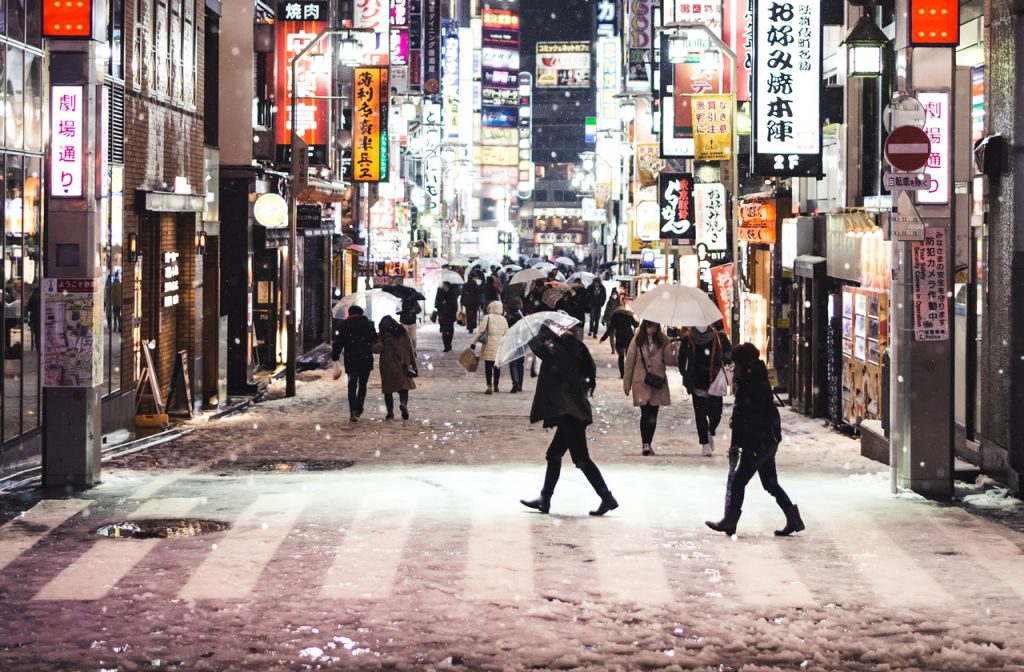
Photo by Ryoji Iwata on Unsplash
Winter in Japan starts from December to February. Sightseeing opportunities may be limited in winter, but that doesn’t mean that it isn’t the best time of the year to visit Tokyo. December is a dry month, but expect rainfall and snow on some occasions. Typically, there is little snowfall in Tokyo. So if you are looking for snow, consider going for day trips outside of Tokyo instead. The city then welcomes the new year with the coldest weather of the year, and although it still snows, they don’t last long like in December. Winter comes to a close in February and there may be a few instances of rain and snow.
Nonetheless, winter is a great time to visit and discover a different side of Tokyo. Christmas in Tokyo is also an exciting experience. The streets are all illuminated by colorful lights and end-of-year sales abound enticing avid shoppers. There are also several hot spring resorts near Tokyo, including Hakone where you can get a view of Mount Fuji while soaking in a hot tub. On January 2 and the Emperor’s Birthday on February 23, the inner grounds of the Imperial Palace are open to the public, giving its visitors a chance to see the gardens. For budget travelers or those who prefer few crowds and low-priced deals, winter is perhaps the best time to visit Tokyo for budget travelers. The only downside is that due to the New Year festivities, some businesses may close for a couple of days.
Festivals and Events in Winter
End the year with a bang and celebrate the start of a new year in Tokyo! Festivals and events in winter are generally centered on the concept of endings and new beginnings, making it the best time to visit Tokyo to witness these changes.
Tokyo Winter Illuminations (Dates vary from October to January) – Gorgeous lights illuminate its trees, city parks, and buildings during this time. In some areas, you can also witness spectacular light shows.
Hatsumōde (January 1) – Technically not a festival, Hatsumōde is an important event as it is the first shrine visit of the new year. Visitors wish for good fortune, and old omamori (small amulets) are returned in exchange for new ones.
Setsubun (First week of February) – Setsubun marks the first day of spring in the traditional lunar calendar. As such, the festival is held to pray for good fortune and ward off evil spirits as a new season starts.
Weather in Winter
| Month | December | January | February |
|---|---|---|---|
| Average Temperature | 4 to 12°C (39.2 to 53.6°F) | 1 to 9°C (33.8 to 48.2°F) | 2 to 10°C (35.6 to 50°F) |
| Average Precipitation | 50mm (2in) | 50mm (2in) | 55mm (2.2in) |
Tourist Seasons in Tokyo
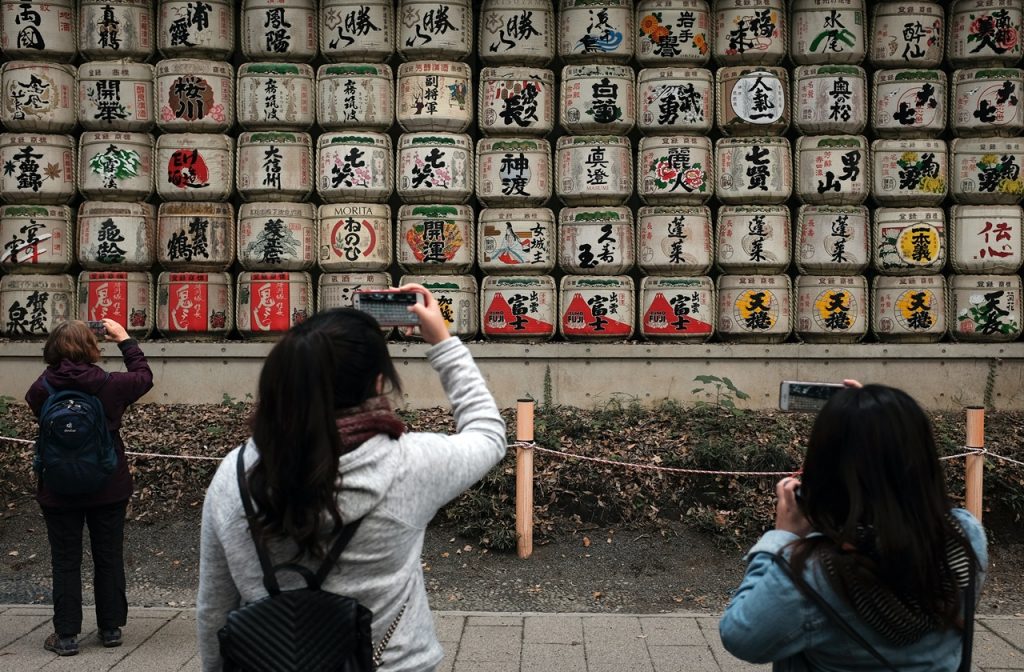
Photo by Hakan Nural on Unsplash
Knowing about the different tourist seasons is a great way of finding out the best time to visit Tokyo. If you’re particular about the crowds or budget, it’s best to avoid the high tourist season where there’s plenty of crowds. Prices for hotels, tickets, and activities are also more expensive in the high season. However, unlike other cities whose tourist seasons fall in between consecutive months, tourist seasons in Tokyo are scattered.
High Season
As Tokyo has many different sightseeing opportunities, there are several high tourist seasons. These high seasons generally have the best weather and tourism options. On the other hand, this also brings the most crowds. If you plan on braving the crowds, make sure to book your hotel and tours months in advance. That way, you can avoid overpaying or running out of places to stay at.
In Tokyo, the high tourist season is from late April to early May during the cherry blossom viewing season. In addition, the country’s Golden Week, a week containing several national holidays in Japan, is also celebrated. During this period, there will be plenty of Japanese traveling locally or abroad. Mid-June to mid-September is another peak tourist season for the city as it is the summer season. July to August also marks the summer vacation for most schools. Thus, large crowds are expected at popular tourist destinations like Tokyo Disneyland, museums, and beaches. The climbing season for Mount Fuji, one of the most iconic mountains in Japan, starts in July, making it a popular time for climbers to visit.
Shoulder Season
A destination’s shoulder season is normally in between the high and low travel season. These months usually occur one or two months before or after the high tourist season. As compared to the high tourist season, shoulder season has fewer crowds and lower prices. On the other hand, shoulder season generally has better weather as compared to the low season. With cheaper airfare and accommodation plus the mild weather and fewer crowds, who wouldn’t be enticed to travel? If you want to enjoy the benefits of the high tourist season without the expensive fees and thick crowds, the shoulder season is the best time to visit Tokyo for you.
Because Tokyo has several high tourist seasons, its shoulder seasons fall between different seasons. The weather from late May to mid-June transitions from pleasant to rainy. But on the upside, you can see the hydrangeas during the rainy days of June. Lastly, mid-September to November are the best months to enjoy the autumn foliage. Crowds from summer would be gone by then, so you can freely explore the temples and other attractions without having to queue for a long time.
Low Season
Weather-wise, the low season in Tokyo usually coincides with the rainy, snowy, and even typhoon season. Tourism-wise, there are fewer tourism opportunities during the low season, which is why airfare, hotel prices, and activities are affordable. This may not be the best time of the year to visit Tokyo if you want to explore, climb mountains, or go sightseeing. However, this is ideal for getting the cheapest deals for plane tickets, hotels, and seasonal tours. You may not get to see much of the city, but who knows what you might discover?
In Tokyo, the low season is from December to February. Winter is a good time to visit Tokyo as it doesn’t get too cold and snowfall is a rare occurrence. Humidity levels are also low so you’ll be able to do a bit of winter sightseeing in comfortable weather. You might not be able to see the fall foliage or the cherry blossom trees, but the winter illuminations of Tokyo make up for that! Christmas markets, end-of-the-year sales, and hot spring baths are also some of the highlights of visiting Tokyo in winter. By the end of February to March, the city slowly starts to bloom when the plum blossoms come to life, ushering in the beginning of spring.
Learn the Seasons to Know the Best Time to Visit Tokyo
When you ask “When is the best time of the year to visit Tokyo?” The answer is simple: all-year-round! The best time to visit the Japanese capital generally depends on your purpose of travel. Do you want to visit when the weather is perfect or when there are fewer tourists? Is there a particular festival or event you plan on catching? These are just some of the important things you have to ask yourself before planning an itinerary.
Now that you’ve figured out the different seasons in Tokyo, and its festivals and events, knowing when is the best time to visit Tokyo is made easier. From the beautiful cherry blossom trees in spring and the stunning winter illuminations, it’s never too late to visit Japan’s capital!

